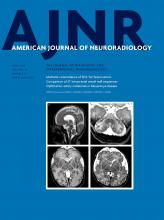Index by author
Achiron, R.
- PediatricsYou have accessVolumetric Brain MRI Study in Fetuses with Congenital Heart DiseaseH. Olshaker, R. Ber, D. Hoffman, E. Derazne, R. Achiron and E. KatorzaAmerican Journal of Neuroradiology June 2018, 39 (6) 1164-1169; DOI: https://doi.org/10.3174/ajnr.A5628
Aggarwal, A.
- Adult BrainOpen AccessSequential Apparent Diffusion Coefficient for Assessment of Tumor Progression in Patients with Low-Grade GliomaI.E. Chen, N. Swinburne, N.M. Tsankova, M.M. Hefti, A. Aggarwal, A.H. Doshi, A. Hormigo, B.N. Delman and K. NaelAmerican Journal of Neuroradiology June 2018, 39 (6) 1039-1046; DOI: https://doi.org/10.3174/ajnr.A5639
Al-haddad, C.E.
- You have accessREPLY:C.E. Al-Haddad, M.G. Sebaaly, R.N. Tutunji, C.J. Mehanna, S.R. Saaybi, A.M. Khamis and R.G. HouraniAmerican Journal of Neuroradiology June 2018, 39 (6) E81; DOI: https://doi.org/10.3174/ajnr.A5647
Almeida, L.
- FunctionalYou have accessSegmentation of the Globus Pallidus Internus Using Probabilistic Diffusion Tractography for Deep Brain Stimulation Targeting in Parkinson DiseaseE.H. Middlebrooks, I.S. Tuna, S.S. Grewal, L. Almeida, M.G. Heckman, E.R. Lesser, K.D. Foote, M.S. Okun and V.M. HolandaAmerican Journal of Neuroradiology June 2018, 39 (6) 1127-1134; DOI: https://doi.org/10.3174/ajnr.A5641
Arnold, M.
- FELLOWS' JOURNAL CLUBInterventionalYou have accessMulticentric Experience in Distal-to-Proximal Revascularization of Tandem Occlusion Stroke Related to Internal Carotid Artery DissectionG. Marnat, M. Bühlmann, O.F. Eker, J. Gralla, P. Machi, U. Fischer, C. Riquelme, M. Arnold, A. Bonafé, S. Jung, V. Costalat and P. MordasiniAmerican Journal of Neuroradiology June 2018, 39 (6) 1093-1099; DOI: https://doi.org/10.3174/ajnr.A5640
Prospectively managed stroke data bases from 2 separate centers were retrospectively studied between 2009 and 2014 for records of tandem occlusions related to internal carotid dissection. The first step in the revascularization procedure was intracranial thrombectomy. Then, cervical carotid stent placement was performed depending on the functionality of the circle of Willis and the persistence of residual cervical ICA occlusion, severe stenosis, or thrombus apposition. Efficiency, complications, and radiologic and clinical outcomes were recorded. Thirty-four patients presenting with tandem occlusion stroke secondary to internal carotid dissection were treated during the study period. The mean age was 52.5 years, the mean initial NIHSS score was 17, and the mean delay between onset and groin puncture was 3.58 hours. Recanalization of TICI 2b/3 was obtained in 21 cases (62%). Fifteen patients underwent cervical carotid stent placement. There was no recurrence of ipsilateral stroke in the nonstented subgroup. The authors conclude that endovascular treatment of internal carotid dissection-related tandem occlusion stroke using the distal-to-proximal recanalization strategy appears to be feasible, with low complication rates and considerable rates of successful recanalization.
Aryal, M.P.
- EDITOR'S CHOICEAdult BrainOpen AccessMultisite Concordance of DSC-MRI Analysis for Brain Tumors: Results of a National Cancer Institute Quantitative Imaging Network Collaborative ProjectK.M. Schmainda, M.A. Prah, S.D. Rand, Y. Liu, B. Logan, M. Muzi, S.D. Rane, X. Da, Y.-F. Yen, J. Kalpathy-Cramer, T.L. Chenevert, B. Hoff, B. Ross, Y. Cao, M.P. Aryal, B. Erickson, P. Korfiatis, T. Dondlinger, L. Bell, L. Hu, P.E. Kinahan and C.C. QuarlesAmerican Journal of Neuroradiology June 2018, 39 (6) 1008-1016; DOI: https://doi.org/10.3174/ajnr.A5675
DSC-MR imaging data were collected after a preload and during a bolus injection of gadolinium contrast agent using a gradient recalled-echo-EPI sequence. Forty-nine low-grade and high-grade glioma datasets were uploaded to The Cancer Imaging Archive. Datasets included a predetermined arterial input function, enhancing tumor ROIs, and ROIs necessary to create normalized relative CBV and CBF maps. Seven sites computed 20 different perfusion metrics. For normalized relative CBV and normalized CBF, 93% and 94% of entries showed good or excellent cross-site agreement. All metrics could distinguish low- from high-grade tumors.
Attaya, Eman
- You have accessPerspectivesEman AttayaAmerican Journal of Neuroradiology June 2018, 39 (6) 993; DOI: https://doi.org/10.3174/ajnr.P0054
Azar, M.
- InterventionalYou have accessSurpass Streamline Flow-Diverter Embolization Device for Treatment of Iatrogenic and Traumatic Internal Carotid Artery InjuriesM. Ghorbani, H. Shojaei, K. Bavand and M. AzarAmerican Journal of Neuroradiology June 2018, 39 (6) 1107-1111; DOI: https://doi.org/10.3174/ajnr.A5607
Bahrami, N.
- Adult BrainOpen AccessEdge Contrast of the FLAIR Hyperintense Region Predicts Survival in Patients with High-Grade Gliomas following Treatment with BevacizumabN. Bahrami, D. Piccioni, R. Karunamuni, Y.-H. Chang, N. White, R. Delfanti, T.M. Seibert, J.A. Hattangadi-Gluth, A. Dale, N. Farid and C.R. McDonaldAmerican Journal of Neuroradiology June 2018, 39 (6) 1017-1024; DOI: https://doi.org/10.3174/ajnr.A5620
Bavand, K.
- InterventionalYou have accessSurpass Streamline Flow-Diverter Embolization Device for Treatment of Iatrogenic and Traumatic Internal Carotid Artery InjuriesM. Ghorbani, H. Shojaei, K. Bavand and M. AzarAmerican Journal of Neuroradiology June 2018, 39 (6) 1107-1111; DOI: https://doi.org/10.3174/ajnr.A5607



